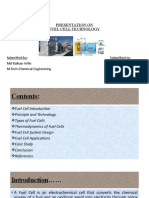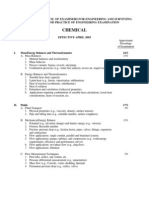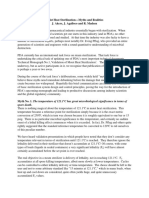247254444
247254444
Uploaded by
Zakariya MohamedCopyright:
Available Formats
247254444
247254444
Uploaded by
Zakariya MohamedOriginal Description:
Copyright
Available Formats
Share this document
Did you find this document useful?
Is this content inappropriate?
Copyright:
Available Formats
247254444
247254444
Uploaded by
Zakariya MohamedCopyright:
Available Formats
Chemical and Process Thermodynamics
Third Edition
B. G. Kyle
Emeritus Professor of Chemical Engineering Kansas State University
Prentice Hall PTR Upper Saddle River, New Jersey 07458
CONTENTS
Preface Notation 1 Introduction
1-1 1-2 1-3 1-4 1-5 1-6 The Anatomy ofThermodynamics The Terminology ofThermodynamics The Variables and Quantities of Thermo Equilibrium and the Equilibrium State The Phase Rule The Reversible Process
2 The First Law of Thermodynamics
2-1 2-2 2-3 2-4 The First Law and Internal Energy The Enthalpy The Heat Capacity The First Lawfor Open Systems Problems
3 The Behavior of Fluids
3-1 3-2 3-3 3-4 3-5 The P VT Behavior of Fluids Equations of State The Ideal Gas The Compressibility Factor Generalized Equations of State Problems
4 The Second Law ofThermodynamics
4-1 4-2 Heat Engines and the Carnot Cycle The Ideal-Gas Carnot Cycle
viii
Contents
4-3 4-4 4-5 4-6 4-7 4-8 4-9 4-10
The Absolute Temperature Scale The Entropy Function Entropy and the Spontaneity of Natural Processes Calculation of Entropy Changes Open Systems Applications of the Second Law The Microscopic View of Entropy The ThirdLaw of Thermodynamics Problems
74 76 78 79 87 88 95 97 98
5 The Thermodynamic Network
5-7 5-2 5-3 5-4 5-5 5-6 5-7 5-8* 5-9* The Free Energy Functions The Clausius Inequality and the Fundamental Equation The Thermodynamic Network Measurable Quantities Calculation ofK and'S asFunctions o/P and T Property Estimation from Corresponding States Property Estimation Via Generalized Equations of State The MethodofJacobians The Generality ofthe Thermodynamic Method Problems
103
104 104 106 108 109 114 118 124 132 138 149 150 151 154 154 155 161 166 173 176 189 197 198 200 203 206 208 214 215
Heat Effects 6-1 6-2 6-3 6-4 6-5 6-6 6-7 6-8 6-9 The Computational Path Heat Effects Due to Change of Temperature Heat Effects Due to Change of Pressure Heat Effects Due to Change of Phase Mixing Heat Effecfts Enthalpy-Concentration Diagrams Chemical Heat Effects Heats of Formation in Solution Applied Thermochemistry Problems
Equilibrium and Stability 7-1 7-2 7-3 7-4 7-5* 7-6* Criteria of Equilibrium The Chemical Potential Application ofthe Equilibrium Criteria The Essence of Thermodynamics Stability Constraints, Equilibrium and Virtual Variations Problems
Contents
ix
8 Thermodynamics of Pure Substances
8-1 8-2 8-3 8-4 8-5 The Phase Diagram The Clapeyron Equation Solid-Liquid Equilibrium Solid- Vapor and Liquid- Vapor Equilibrium Presentation of Thermodynamic Property Data Problems
217
217 220 223 225 229 233
9 Principles of Phase Equilibrium
9-1 9-2 9-3 9-4 9-5 9-6 9-7 9-8 9-9 9-10 9-11 9-12 9-13 Presentation of Vapor-Liquid Equilibrium Data Determination of Vapor-Liquid Equilibrium Data The Thermodynamic Basis for the Phase Rule The Fugacity Determination ofFugacities ofPure Substances Determination ofFugacities in Mixtures Ideal Systems The Activity Coefficient Experimental Determination ofActivity Coefficients Henry's Law Activity Coefficient Equations Phase Equilibrium Via an Equation of State The Thermodynamic Approach to Phase Equilibrium Problems
239
240 244 246 247 249 258 261 270 274 278 279 291 299 302 309 313 319 325 327 332 337 340 346 350 352 359 362
10
Applied Phase Equilibrium 10-1 The Consummate Thermodynamic Correlation of Vapor-Liquid Equilibrium 10-2 Constant-Pressure VLEData 10-3 Total Pressure Data 10-4 Azeotropes 10-5 Thermodynamic Consistency Tests 10-6 Multicomponent Vapor-Liquid Equilibrium 10-7 Phase Behavior in Partially Miscible Systems 10-8 Liquid-Liquid Equilibrium 10-9* Ternary Liquid-Liquid Equilibrium 10-10 Estimates from Fragmentary Data 10-11 Recapitulation Problems
Contents
11
Additional Topics in Phase Equilibrium 11-1 11-2 11-3 11-4* 11-5* 11-6* 11-7* 11-8* Partial Molar Properties Experimental Determination q/Mixture and Partial Molar Properties Mixture Properties for Ideal Solutions Activity Coefficients Based on Henry 's Law The Solubility of Gases in Liquids Solid-Liquid Equilibria Solid-Supercritical Fluid Equilibrium Prediction of Solution Behavior Problems
375 375 3 78 384 386 390 394 410 412 420
12 Chemical Equilibrium
12-1 12-2 12-3 12-4 12-5 12-6 12-7 12-8 12-9 12-10* 12-11* 12-12* Generalized Stoichiometry The Condition of Equilibrium for a Chemical Reaction Standard States and AG Temperature Dependence ofthe Equilibrium Constant Experimental Determination ofThermochemical Data Other Free Energy Functions Homogeneous Gas-Phase Reactions Heterogeneous Chemical Equilibrium Reactions in Solution Reactions in Aqueous Solution Electrolyte Solutions Coupled Reactions Problems
433
435 437 440 444 446 454 456 462 468 478 486 505 511 529 530 548 55 7 571 579 581
13
Complex Chemical Equilibrium 13-1 The Phase Rulefor Reacting Systems 13-2* Analyzing Complex Chemical Equilibrium Problems 13-3 * Formulating Complex Chemical Equilibrium Problems 13-4* The CHO System and Carbon Deposition Boundaries 13-5* The Si-Cl-H System and Silicon Deposition Boundaries Problems
14 Thermodynamic Analysis of Processes
14-1 14-2 14-3 Work and Free Energy Functions The Availability Mixing and Separation Processes
589
589 591 600
Contents
xi
14-4* 14-5
Heat Exchange Systems Involving Chemical Transformations Problems
607 614 632
15 Physicomechanical Processes
15-1 15-2 15-3 15-4 15-5 15-6 15-7 Compression and Expansion of Gases The Joule-Thomson Expansion Liquefaction of Gases Refrigeration Heat Pumps Power Generation Cogeneration of Steam and Power Problems
639
640 643 645 654 661 662 667 671
16 Compressible Fluid Flow
16-1 16-2 16-3 16-4 16-5 The Basic Equations of Fluid Mechanics Sonic Velocity Isentropic Flow Isentropic Flow Through Nozzles Nonisentropic Flow Problems
677
678 681 683 685 689 693
17 Thermodynamics and Models
17-1* 17-2* 17-3* Standard Models Ad Hoc Models Evaluation of Models Problems
697
698 703 719 722 729
Appendix A Table A-l FigureA-1 Appendix B Table B-l Molar Heat Capacities of Gases at Zero Pressure Critical Constants of Selected Substances Equilibrium Constants for Selected Reactions
729 731 732 732
xii
Contents
Appendix C
Table C-l Table C-2 Thermodynamic Properties of Saturated Steam Thermodynamic Properties ofSuperheated Steam
734
734 737
Appendix D
Table D-l Table D-2 Table D-3 Appendix E Inventory ofthe CD-ROM Appendix F Properties ofDeterminants Index
742
Enthalpies and Free Energies of Formation of Selected Organic Compounds 742 Enthalpies and Free Energies of Formation of Selected Inorganic Compounds 744 Free Energies of Formation of Selected Ions in the Aqueous State 745 746 746 751 751 753
You might also like
- CEIC2000 Exam 2016 MainDocument18 pagesCEIC2000 Exam 2016 MainMeena LochniNo ratings yet
- MSG 01114Document4 pagesMSG 01114amalinaishah0% (1)
- 1st Year Laboratory Report 1Document11 pages1st Year Laboratory Report 1Rimaz RameezNo ratings yet
- COMSATS University Islamabad, Lahore Campus: Assignment 1 - Chemical Reaction Engineering SP-2021Document1 pageCOMSATS University Islamabad, Lahore Campus: Assignment 1 - Chemical Reaction Engineering SP-2021Samaha FatimaNo ratings yet
- CH126P Lec 8 - Ch9Document20 pagesCH126P Lec 8 - Ch9kumiristineNo ratings yet
- J. Chem. Thermodynamics: J. Soujanya, B. Satyavathi, T.E. Vittal PrasadDocument4 pagesJ. Chem. Thermodynamics: J. Soujanya, B. Satyavathi, T.E. Vittal PrasadAngie Paola AcostaNo ratings yet
- A Priori Phase Equilibrium Prediction From A Segment Contribution Solvation Model - Lin and SandlerDocument15 pagesA Priori Phase Equilibrium Prediction From A Segment Contribution Solvation Model - Lin and SandlerErick David Ravello SaldañaNo ratings yet
- The Layout of Fluid Mechanics and Hydraulic Machinery LabDocument4 pagesThe Layout of Fluid Mechanics and Hydraulic Machinery LabAhmad RazaNo ratings yet
- Hydrogen Production TechnologiesFrom EverandHydrogen Production TechnologiesMehmet SankirNo ratings yet
- Chemical Engineering Analysis - CHE 411Document20 pagesChemical Engineering Analysis - CHE 411David AkomolafeNo ratings yet
- Research 2 Duplex Pump: GradeDocument10 pagesResearch 2 Duplex Pump: GradeAli Requiso MahmudNo ratings yet
- Lecture 2 MassMicroDocument25 pagesLecture 2 MassMicroPelin KınıkNo ratings yet
- Influence of Activated Sludge Flocculation Time On Secondary ClarificationDocument8 pagesInfluence of Activated Sludge Flocculation Time On Secondary ClarificationRC Dela RocaNo ratings yet
- Dimensionless NumbersDocument15 pagesDimensionless NumbersHaider Ali100% (1)
- Chemical Process Design 1Document15 pagesChemical Process Design 1sanelelembede09100% (1)
- Chapter 1 PDFDocument74 pagesChapter 1 PDFLi Tan100% (1)
- Manufacture of Acetylene by Paraffin Hydrocarbons : Wulff ProcessDocument8 pagesManufacture of Acetylene by Paraffin Hydrocarbons : Wulff ProcessTones&Feels100% (1)
- 1 s2.0 S0263876299717624 MainDocument7 pages1 s2.0 S0263876299717624 Mainryan123459No ratings yet
- Unsteady State Heat and Mass TransferDocument14 pagesUnsteady State Heat and Mass Transfernhalieza1067No ratings yet
- Design and Modeling of Post-Denitrification Single-Sludge Activated Sludge ProcessesDocument10 pagesDesign and Modeling of Post-Denitrification Single-Sludge Activated Sludge Processesapi-285664468No ratings yet
- Assignment SolutionDocument24 pagesAssignment SolutionOlumayegun OlumideNo ratings yet
- Process Dynamics & Control ReportDocument26 pagesProcess Dynamics & Control ReportDonna Joy MallariNo ratings yet
- Green Engg AllenDocument6 pagesGreen Engg AllenH.J.PrabhuNo ratings yet
- Dynamic MeshDocument34 pagesDynamic MeshAmr HitchNo ratings yet
- 10 Introduction To Complex Distillation MethodsDocument40 pages10 Introduction To Complex Distillation MethodsAhmet BaykanNo ratings yet
- Annular Condensation CFD Models For The Water-Steam in The Heat Pipe SystemsDocument9 pagesAnnular Condensation CFD Models For The Water-Steam in The Heat Pipe SystemsRashed KaiserNo ratings yet
- A Review of Heat Transfer and Pressure Drop Correlations For Laminar Flow in Curved Circular DuctsDocument26 pagesA Review of Heat Transfer and Pressure Drop Correlations For Laminar Flow in Curved Circular DuctsRiddhesh PatelNo ratings yet
- Experimental Thermal and Fluid Science: S.S. Pawar, Vivek K. SunnapwarDocument13 pagesExperimental Thermal and Fluid Science: S.S. Pawar, Vivek K. SunnapwarAnonymous mXicTi8hBNo ratings yet
- Presentation Fuel CellDocument25 pagesPresentation Fuel CellRaihanNo ratings yet
- Thermal Boundary Layer SolutionDocument6 pagesThermal Boundary Layer Solutionmsnaghavi100% (3)
- Results and Discussion of CSTR in SeriesDocument3 pagesResults and Discussion of CSTR in SeriesleenzalalNo ratings yet
- Grou 3 Distillation AssignmentDocument26 pagesGrou 3 Distillation AssignmentSimesihle ZamisaNo ratings yet
- All ProblemsDocument29 pagesAll Problemsahmed hatemNo ratings yet
- Shell and Tube Heat ExchangerDocument14 pagesShell and Tube Heat ExchangerSelvi RNo ratings yet
- 29 Ethyl Acetate LQDocument3 pages29 Ethyl Acetate LQAlisa MinasyanNo ratings yet
- Experiment No,-3 (A) : Mass Transfer Lab IIT KGPDocument3 pagesExperiment No,-3 (A) : Mass Transfer Lab IIT KGPSiddharth MohapatraNo ratings yet
- Cheng 323 Chap 4Document82 pagesCheng 323 Chap 4Faisal Mumtaz100% (2)
- Analysis and Enhancement of Hydraulic Ram Pump Using Computational Fluid Dynamics (CFD)Document25 pagesAnalysis and Enhancement of Hydraulic Ram Pump Using Computational Fluid Dynamics (CFD)IJIRSTNo ratings yet
- ProposalDocument32 pagesProposalS Kiong TingNo ratings yet
- 58203-mt - Process Modelling and SimulationDocument2 pages58203-mt - Process Modelling and SimulationSRINIVASA RAO GANTANo ratings yet
- Refrigerator: Refrigerator Transfers Heat From A Low-Temperature Medium To A Higher Temperature MediumDocument1 pageRefrigerator: Refrigerator Transfers Heat From A Low-Temperature Medium To A Higher Temperature MediumAdonis A. ClosasNo ratings yet
- Pinch Technology by ShubhamDocument29 pagesPinch Technology by Shubhamapi-381283583% (6)
- Micro Heat Pipes and Micro Heat Spreaders - PetersonDocument37 pagesMicro Heat Pipes and Micro Heat Spreaders - PetersonprinciquesoNo ratings yet
- ME303 7 Head Loss 2 BranchedDocument39 pagesME303 7 Head Loss 2 Branchedtoshugo100% (1)
- Process Control and InstrumentationDocument14 pagesProcess Control and InstrumentationSiddhant SinhaNo ratings yet
- Ex. 11Document18 pagesEx. 11Zaher Zaher100% (1)
- Unit V EvaporationDocument23 pagesUnit V EvaporationpavijayaNo ratings yet
- Chajptjer: Dynamic Behavior of Linear Low-Order SystemsDocument35 pagesChajptjer: Dynamic Behavior of Linear Low-Order SystemsMamounNo ratings yet
- Ch.2 QADocument9 pagesCh.2 QArogers4759100% (1)
- Presentation On Synthetic Refrigerant AdditiveDocument10 pagesPresentation On Synthetic Refrigerant Additivevivek sinha100% (1)
- 3 ConvectionDocument44 pages3 ConvectionromasokyNo ratings yet
- Paper, Synthetic Refrigerants, 7966, 01.04 Cutmarks PDFDocument8 pagesPaper, Synthetic Refrigerants, 7966, 01.04 Cutmarks PDFAnamarija ŠkovrljNo ratings yet
- Refrigeration Test RigDocument7 pagesRefrigeration Test Rigshibin874141100% (1)
- Lecture Five Energy BalancesDocument51 pagesLecture Five Energy BalancesHebron DawitNo ratings yet
- Intrinsic and Global Reaction Rate of Methanol Dehydration Over G Al2O3 Pellets 1992 Industrial and Engineering Chemistry Research1992Document7 pagesIntrinsic and Global Reaction Rate of Methanol Dehydration Over G Al2O3 Pellets 1992 Industrial and Engineering Chemistry Research1992pannita.kNo ratings yet
- Design of HXDocument5 pagesDesign of HXvikirhythmNo ratings yet
- CAPS - 3170507 - Common Lab Manual With AcknowDocument67 pagesCAPS - 3170507 - Common Lab Manual With AcknowVarun pandeyNo ratings yet
- Cooling Tower DiscussionDocument4 pagesCooling Tower DiscussionnamdohyonNo ratings yet
- Pe Chemical Exam SpecsDocument4 pagesPe Chemical Exam SpecsJagadeesh Unnam0% (1)
- H83PDC H83PDC H83PDC H83PDC - Process Process Process Process Dynamic & Control Dynamic & Control Dynamic & Control Dynamic & ControlDocument17 pagesH83PDC H83PDC H83PDC H83PDC - Process Process Process Process Dynamic & Control Dynamic & Control Dynamic & Control Dynamic & ControlZakariya MohamedNo ratings yet
- Transport Phenomena: DR Hii Ching Lik Department of Chemical & Environmental EngineeringDocument8 pagesTransport Phenomena: DR Hii Ching Lik Department of Chemical & Environmental EngineeringZakariya MohamedNo ratings yet
- Life (Its Building Blocks & Processes) : H83BCE Biochemical EngineeringDocument16 pagesLife (Its Building Blocks & Processes) : H83BCE Biochemical EngineeringZakariya MohamedNo ratings yet
- Distillation 1Document42 pagesDistillation 1Zakariya MohamedNo ratings yet
- Answer For PLD Final ExamsDocument3 pagesAnswer For PLD Final ExamsZakariya MohamedNo ratings yet
- Tryout Exam - SolutionDocument8 pagesTryout Exam - SolutionZakariya MohamedNo ratings yet
- Atomic Absorption Spectroscopy: J12ANM Analytical MeasurementDocument19 pagesAtomic Absorption Spectroscopy: J12ANM Analytical MeasurementZakariya MohamedNo ratings yet
- Equipment DesignDocument11 pagesEquipment DesignZakariya MohamedNo ratings yet
- Lecture 5 - Pump SelectionDocument12 pagesLecture 5 - Pump SelectionZakariya MohamedNo ratings yet
- Tutorial OneDocument2 pagesTutorial OneZakariya MohamedNo ratings yet
- Lecture 4 - Heat Exchanger DesignDocument20 pagesLecture 4 - Heat Exchanger DesignZakariya MohamedNo ratings yet
- Process Economics II Process Economics II Process Economics II Process Economics IIDocument1 pageProcess Economics II Process Economics II Process Economics II Process Economics IIZakariya MohamedNo ratings yet
- Solid Waste CharacteristicsDocument8 pagesSolid Waste CharacteristicsZakariya MohamedNo ratings yet
- Low Weightage High WeightageDocument5 pagesLow Weightage High WeightagegalilitNo ratings yet
- BP Water Cooling SystemDocument62 pagesBP Water Cooling SystemLTE002No ratings yet
- Trial Terengganu SPM 2014 Physics K1 K2 K3 SkemaDocument16 pagesTrial Terengganu SPM 2014 Physics K1 K2 K3 SkemaCikgu Faizal100% (2)
- POWER2016-59259: Numerical Modeling of Liquid-To-Vapor Phase Change in Porous Medium Under Solar Heat LocalizationDocument6 pagesPOWER2016-59259: Numerical Modeling of Liquid-To-Vapor Phase Change in Porous Medium Under Solar Heat LocalizationFriday Niyehmi Abolorunke ChristopherNo ratings yet
- Interview Preparation Guidelines For Fresh EngineerDocument3 pagesInterview Preparation Guidelines For Fresh EngineerMUHAMMAD AWAIS UR REHMANNo ratings yet
- Neet (Aipmt) PDFDocument114 pagesNeet (Aipmt) PDFPallav JainNo ratings yet
- Reversible and Irreversible ProcesesDocument12 pagesReversible and Irreversible ProcesesFarouk BassaNo ratings yet
- Entropy ExplainedDocument4 pagesEntropy ExplainedATUL SONAWANENo ratings yet
- Chapter 3Document28 pagesChapter 3Anonymous lOMOpX3No ratings yet
- Stihler Astotherm Blood and Infusion Warmer - Service Manual PDFDocument53 pagesStihler Astotherm Blood and Infusion Warmer - Service Manual PDFLily FloresNo ratings yet
- Study Unit - Automotive Cooling SystemsDocument104 pagesStudy Unit - Automotive Cooling SystemsWalter SarajevoNo ratings yet
- PHY112 Lecture1Document131 pagesPHY112 Lecture18wc9sncvpwNo ratings yet
- Design and Development of Energy Efficient Solar Tunnel Dryer For Industrial DryingDocument9 pagesDesign and Development of Energy Efficient Solar Tunnel Dryer For Industrial DryingManish JoshiNo ratings yet
- Moist Heat Sterilization MythsDocument10 pagesMoist Heat Sterilization MythsmmyNo ratings yet
- Energy Demand in Wood Processing Plants: Jingge Li, Murray Mccurdy, Shusheng PangDocument9 pagesEnergy Demand in Wood Processing Plants: Jingge Li, Murray Mccurdy, Shusheng PangsabrahimaNo ratings yet
- ThermochemistryDocument22 pagesThermochemistryongkikoNo ratings yet
- Automatic Fire Detector SpacingDocument14 pagesAutomatic Fire Detector SpacinghidayatmaNo ratings yet
- AP X Physics EMDocument352 pagesAP X Physics EMsurya_kotniNo ratings yet
- Physical Chemistry 2e 2024 - 240627 - 212820Document1,237 pagesPhysical Chemistry 2e 2024 - 240627 - 212820organomazeNo ratings yet
- B S T Year 5Document9 pagesB S T Year 5INCREASE & ABUNDANT SCHOOLSNo ratings yet
- Mechanical Intro 17.0 M07 Modal Thermal and Multistep AnalysisDocument59 pagesMechanical Intro 17.0 M07 Modal Thermal and Multistep AnalysisSamedŠkuljNo ratings yet
- IX-1-Matter in Our SurroundingsDocument36 pagesIX-1-Matter in Our SurroundingsR Krithiga SriramNo ratings yet
- Intercambiador de CalorDocument55 pagesIntercambiador de Calorandy pandaNo ratings yet
- 4 ThermochemistryDocument34 pages4 ThermochemistryNurl Aina100% (2)
- Assignment1 KJM 442 Oct 2021 - Jan 2022Document16 pagesAssignment1 KJM 442 Oct 2021 - Jan 2022Amirul HazzmiNo ratings yet
- CWEng Brochure (Sirim)Document2 pagesCWEng Brochure (Sirim)Amir NorNo ratings yet
- Ventilation Calculation For The Transformer Room AssumptionDocument7 pagesVentilation Calculation For The Transformer Room AssumptionsamehNo ratings yet
- Constant Volume Heat Capacity, CV, M, of SO2 Derived From Vibrational-Rotational IR Spectra, and Temperature Determination of CO Through Statistical ThermodynamicsDocument26 pagesConstant Volume Heat Capacity, CV, M, of SO2 Derived From Vibrational-Rotational IR Spectra, and Temperature Determination of CO Through Statistical ThermodynamicsWill Hodds100% (1)
- Science 8 7.1 Differentiating Heat and TemperatureDocument52 pagesScience 8 7.1 Differentiating Heat and TemperatureYomiko Danise P. EloresNo ratings yet
- Heat Capacity - Chemistry LibreTextsDocument5 pagesHeat Capacity - Chemistry LibreTextsshiel175No ratings yet






































































































